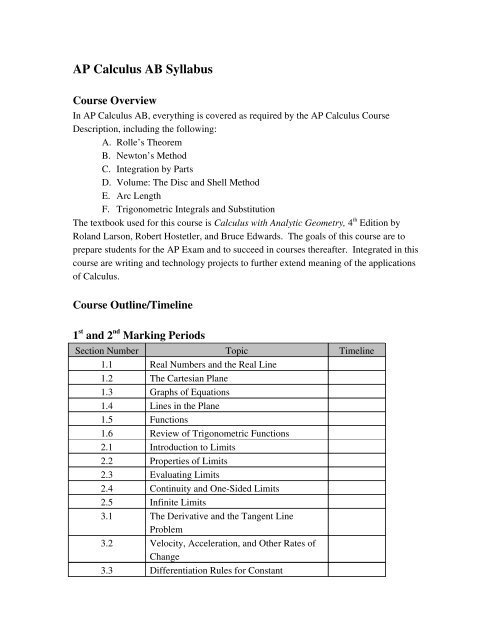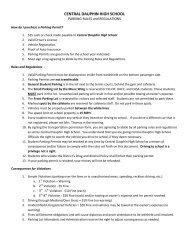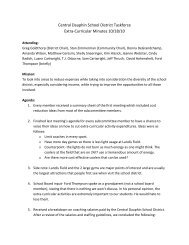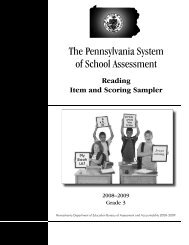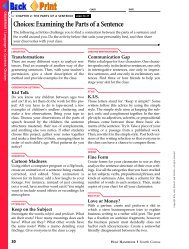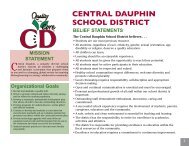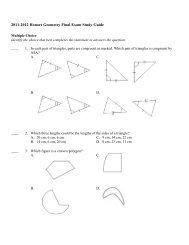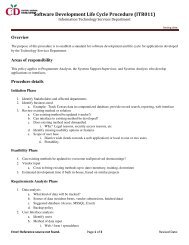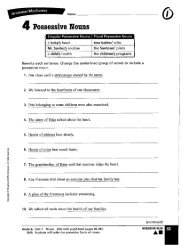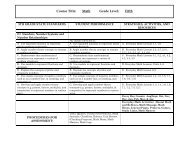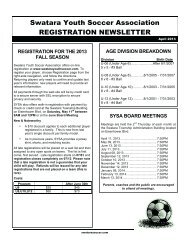AP Calculus AB Syllabus
AP Calculus AB Syllabus
AP Calculus AB Syllabus
You also want an ePaper? Increase the reach of your titles
YUMPU automatically turns print PDFs into web optimized ePapers that Google loves.
<strong>AP</strong> <strong>Calculus</strong> <strong>AB</strong> <strong>Syllabus</strong>Course OverviewIn <strong>AP</strong> <strong>Calculus</strong> <strong>AB</strong>, everything is covered as required by the <strong>AP</strong> <strong>Calculus</strong> CourseDescription, including the following:A. Rolle’s TheoremB. Newton’s MethodC. Integration by PartsD. Volume: The Disc and Shell MethodE. Arc LengthF. Trigonometric Integrals and SubstitutionThe textbook used for this course is <strong>Calculus</strong> with Analytic Geometry, 4 th Edition byRoland Larson, Robert Hostetler, and Bruce Edwards. The goals of this course are toprepare students for the <strong>AP</strong> Exam and to succeed in courses thereafter. Integrated in thiscourse are writing and technology projects to further extend meaning of the applicationsof <strong>Calculus</strong>.Course Outline/Timeline1 st and 2 nd Marking PeriodsSection Number Topic Timeline1.1 Real Numbers and the Real Line1.2 The Cartesian Plane1.3 Graphs of Equations1.4 Lines in the Plane1.5 Functions1.6 Review of Trigonometric Functions2.1 Introduction to Limits2.2 Properties of Limits2.3 Evaluating Limits2.4 Continuity and OneSided Limits2.5 Infinite Limits3.1 The Derivative and the Tangent LineProblem3.2 Velocity, Acceleration, and Other Rates ofChange3.3 Differentiation Rules for Constant
Multiples, Sums, Powers, Sines and Cosines3.4 Differentiation Rules for Products,Quotients, Secants and Tangents3.5 The Chain Rule3.6 Implicit Differentiation3.7 Related Rates4.1 Extrema on an Interval4.2 Rolle’s Theorem and the Mean ValueTheorem4.3 First Derivative Test andIncreasing/Decreasing Functions4.4 Concavity and the Second Derivative4.5 Limits at Infinity4.7 Optimization Problems4.8 Newton’s Method4.9 Differentials3 rd and 4 th Marking PeriodsSection Number Topic Timeline5.1 Antiderivatives and Indefinite Integrals5.2 Area5.3 Riemann Sums and Definite Integrals5.4 The Fundamental Theorem of <strong>Calculus</strong>5.5 Integration by Substitution5.6 Trapezoidal Rule6.1 Natural Log Function and Differentiation6.2 Natural Log and Integration6.3 Inverse Functions6.4 Exponential Functions and Differentiationand Integration6.5 Bases Other than e and Applications6.6 Growth and Decay6.7 Inverse Trigonometric Functions andDifferentiation6.8 Inverse Trigonometric Functions:
Integration and Completing the Square8.1 Basic Integration Formulas8.2 Integration by Parts7.1 Area of a Region Between Two Curves7.2 Volume: The Disc MethodAfter the <strong>AP</strong> Exam:Section Number Topic Timeline7.4 Arc Length and Surfaces of Revolution7.5 Work8.2 Integration by Parts8.3 Trigonometric Integrals8.4 Trigonometric SubstitutionTeaching StrategiesStudents beginning the <strong>AP</strong> course are made aware of the main focus of the course. Theywill experience a rigorous schedule that will prepare them for the <strong>AP</strong> Exam. Throughoutthe year, students spend time on problems that are related to the <strong>AP</strong> Exam based onrecently learned topics.Technology and Computer SoftwareTeachers and students use the TI83 and TI89 graphing calculators.• In the chapter on derivatives, students will be shown how to use the NDERfunction.• Students will become familiar with the trace function on their graphing calculatorto find solutions like extreme values, i.e.• Students will learn how to find definite integrals using NINT and interpretingwhat this value meansStudent EvaluationGrades are calculated quarterly, which is a compilation of tests, quizzes, projects andhomework. Each quarter grade is worth 20% of the final grade, with a midterm and a
final examination worth 10%. Beginning the 20062007 school year, students may optout of the final examination by taking the <strong>AP</strong> Exam.Tests are represent a similar format to the <strong>AP</strong> Exam. They include multiple choice andshortanswer questions, taken over a 2day period. Quizzes are administered based onthe topic, and homework is collected at random. Projects are delegated quarterly basedon the topic covered.Graphing calculators are allowed on 80% of the exams/quizzes.Teacher ResourcesPrimary TextbookLarson, Roland, Hostetler, Robert, and Edwards, Bruce. <strong>Calculus</strong> with AnalyticGeometry. 4 th ed. Lexington: D.C. Heath and Company, 1990.Supplementary TextbooksFinney, Ross L., Demana, Franklin D., Waits, Bert K., Kennedy, Daniel. <strong>Calculus</strong>:Graphical, Numerical, Algebraic. New Jersey: Pearson Education, Inc,. Publishing asPrentice Hall, 2003.Student Activities1. As a real life example, Officer Curt McCoy, a former accident reconstructionist,presents a discussion/problem solving session on PVA.2. Students utilize the trapezoidal rule to measure the surface area of a pothole in thestudent parking lot. Students will utilize their graphing Calculators due to themany measurements that are taken at the site.3. Students work on a “Webquest” which requires to locate specific information inorder to complete an essay on the correlation between Leo Tolstoy’s War and
Peace and Integral <strong>Calculus</strong>. This provides writing opportunities to further theirunderstanding of Integral <strong>Calculus</strong> and how it relates to the literary world.4. In the beginning of the course, students are briefly reintroduced to functions.This includes, notation, properties, etc. Continuity and Discontinuity offunctions, as well as asymptotes are discussed. This is to help them prepare forlimits. Students will have to complete problems on their own at the beginning ofthe period. Here is an example of what they are required to complete:Consider the function f(x) = x 2 – 2x on the interval [5,5].x 3 – 9xA. Give any zeros of f(x)B. Give equations of all asymptotes. Justify your answer.C. List all points where f(x) is discontinuous. Use the definition ofcontinuity to justify your answer.D. Sketch f(x).Later in the course, students are to use this problem to calculate the limit of thefunction as is approaches 2.Websites1. http://www.swgeorgia.resa.k12.ga.us/Math.html this website is useful forstudents in their notetaking by providing graphic organizers – a concept fromLearning Focused Schools2. http://www.pen.k12.va.us/Div/Winchester/jhhs/math/lessons/trig/assign.html andhttp://www.pen.k12.va.us/Div/Winchester/jhhs/math/lessons/calculus.html awebsite that provides activities to enhance Precalculus concepts and <strong>Calculus</strong>worksheets3. http://www.calculushelp.com/funstuff/phobe.html a website designed todescribe concepts learned in the first few chapters4. http://archives.math.utk.edu/visual.calculus this website is designed to teachmost concepts learned in the <strong>AP</strong> <strong>Calculus</strong> course. Includes both definite andintegral calculus examples with graphs.


